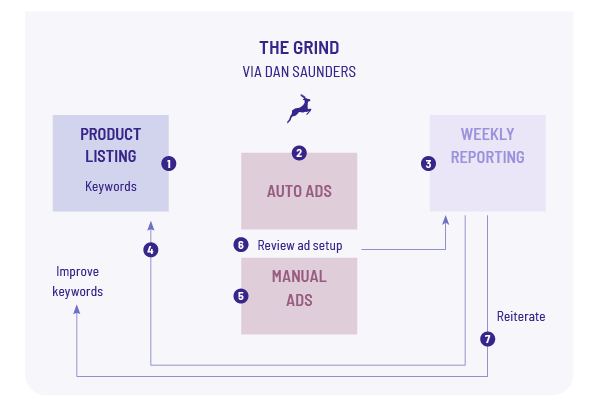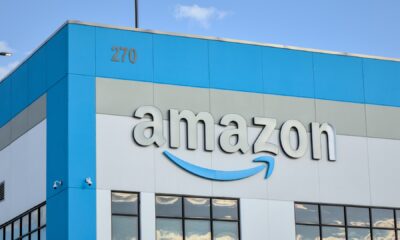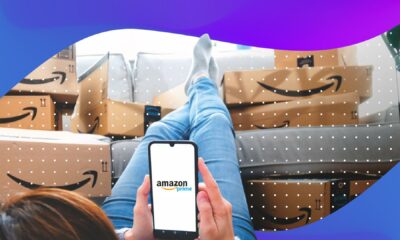AMAZON
The Grind! How to Rank Higher on Amazon

Oh, what a grind it can be to filter through reports to identify the winning and losing keywords, then update campaign settings, create targeted manual ads, include negative keywords and even update product listings sometimes. But hey, it works!
This is one of the most common optimization strategies on Amazon today and it is also one of the most efficient ones. It involves a number of different mechanisms which work together closely. On Amazon, there isn’t a big distance between SEO, CRO and PPC as you often find in relation with search marketing for Google.
We can organize the work on optimizing for Amazon into five key areas that will all help you rank higher on Amazon:
- Organic
- PPC
- CRO
- Outside referrals
- Sales
In terms of organic ranks, content is a very important ranking factor and what you really need to focus on is your product. This is about making your product listings and your brand store look the best.
How to structure your title
Just like it is one of the key elements for good old SEO, the title for your product listing is an important part of your organic optimization.
- Use your keywords in order of importance even if that means putting your brand 2nd.
- Optimise your title readability for mobile, desktops and your ads.
Title Text Lengths
- For desktop organic results use around 115-144 characters.
- PPC will pull 30-33 characters of your product title.
- Organic mobile titles will pull about 55-63 characters.
Back end search terms are by far the most important tool for organic ranking on Amazon. Enter all your keywords that you can’t fit into your product listings and descriptions. It’s not visible to customers but is indexed by Amazon. There are only however, an extra 250 characters available to be indexed. This is where you should include common misspellings however, you don’t need to worry about punctuation, singular or plural words as Amazon will take this into account.
Amazon Keyword Research
For keyword research there are many tools you can use. Ahrefs, Helium 10, JungleScout and Factor A are some of them. You can even use Google Ads!
Amazon PPC
Amazon offers 2 advertising solutions. The Amazon DSP is a programmatic advertising based on CPM (cost per mille) and the Amazon Sponsored Ads solution is based on CPC (cost per click). That’s the one we are interested in!
This is where we can bid you welcome to Amazon Adwords. The Sponsored products solution is primarily based on keyword targeting very similar to Google Ads.
This is the easiest way to drive your sales up on Amazon. Start by running automatic campaign suggested to you by Amazon then transfer the successful keywords to manual PPC campaigns to target your keywords, then pump up the bids to drive exposure. Running your paid activity for a short period at cost or even at a loss will be worthwhile to increase your organic ranking.
- You type in the campaign name, so you can monitor the results.
- Add in how much your daily budget is
- Pick the dates you want your campaign to run.
Now it’s time to set the key words you want to target – again, you have the choice to do this manually or automatically through Amazon. Like on AdWords, you can decide if you want the keywords to match exactly, broadly or as a phrase. A mixture of all three is the best way forward.
PPC boosts your organic, so it’s worth running at an initial loss or, better yet, break even for the initial gains. Plus, you get the added benefit of having an initial surge of data that you can use to refine your own process and learn more about your customers.
It all really depends what your acos (Advertising Cost of Sales – the percent of ad spend divided by the attributed sale). You can see this number in the Keyword section of your advertising tab.
Attributed Sales (how many sales you made that week that are directly linked to your ad) are important. If by the 2nd or 3rd campaign you’re not showing a weekly ROI, there’s a good chance you’ve not targeted the right keywords.
Not only will this cost you money, but it’ll be ruining your CRO on your Amazon account, which is an Amazon Ranking factor. Impressions (the number of times your ads were displayed) are important, but not at the cost of lowering your rankings
CRO
The best tool I can recommend is Sellerly by SEMrush. It offers you the ability to AB test your products and your ads
- Customer reviews: The higher your reviews, the higher Amazon is going to rank you. Like Google, you need to get a few reviews before Amazon starts to rank you against the bigger competitors.
- Image size and quality: Use all the photo spaces you’re slowed and they all must be 1000 x1000 pixels so your buyer can zoom in from all angles.
- Price: Amazon will always values its buyers over its sellers, it will always push the best seller, which is most likely the lowest price to the top, so you need to audit your competitors regularly to see what they are charging.
- Exit rates: If someone looks at your product then immediately exits the Amazon site, Amazon will lower your ranking. If you are in no way misleading, this won’t be a problem.
- Bounce rate: Same as the above, if someone lands on your product then leaves quickly to look at someone else’s, Amazon will penalise you.
- What’s the best way to get conversion? Offer a deal.
The biggest ranking factor of all is Sales and driving traffic from outside of Amazon. These are Amazon’s equivalent to links for Google SEO. The more sales you have, the higher you’ll rank. If you start to outsell your competitors who outrank you for your keywords, Amazon will reward you with a higher ranking. Using Facebook, Twitter and even Google to drive traffic to your product will also help you rank faster and higher on Amazon.
Source : « Marketing on Amazon in 2020 », Innovell February 2020, https://www.innovell.com/amazon-marketing-report/


















